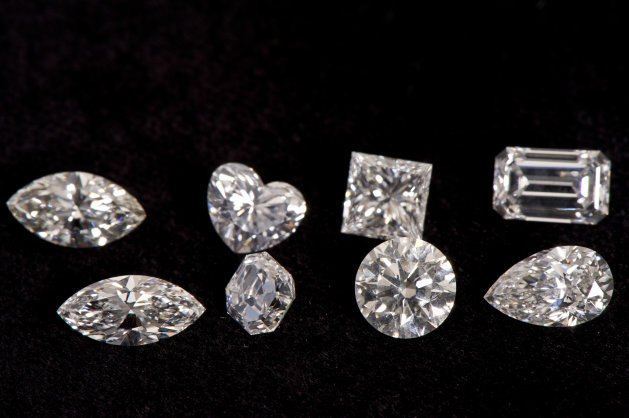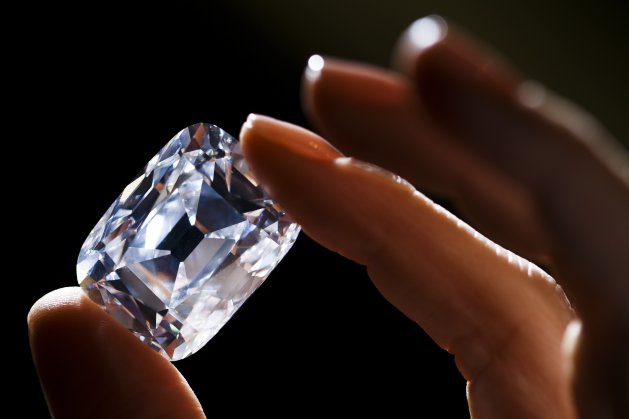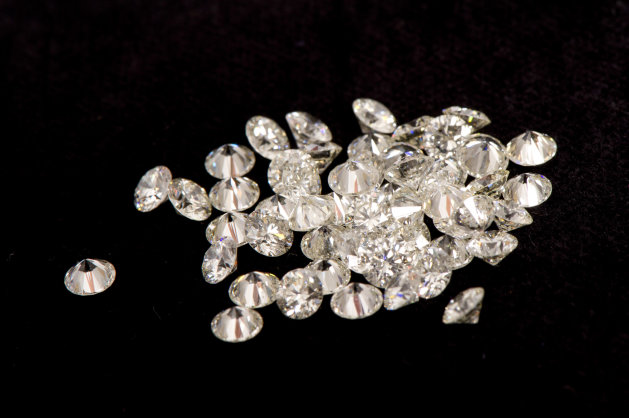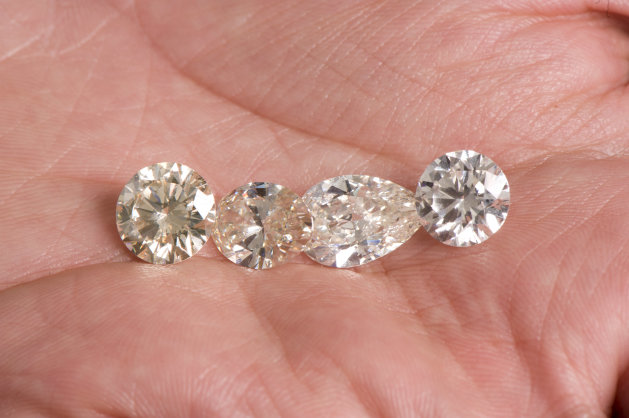Just how do you value a diamond?
One of these stones is worth £1,000 more than the other – but which one...
These diamonds are the same diameter (7.9mm), the one on the left is 1.8 carats, the one on the right 2 carats and has more sparkle. But the one on the left – despite being smaller – is worth more.
Why? A tiny imperfection in the one on the right and a greater clarity in the one on the left.
Confused? You might well be, because while everyone knows diamonds are worth a lot of money (the two pictured above are worth £29,000 between them) actually putting a value on a diamond is something most people struggle with. So how do you know if you’re being ripped off?
“There are 6,000 different categories of diamond,” Vashi Dominguez, founder of DiamondManufacturers.co.uk and with more than a decade of experience in the industry, told Yahoo! Finance.
Shape, colour, size, cut, clarity, brilliance and imperfections (or lack of them) all determine the price of a diamond.
 Different cuts of diamonds
Different cuts of diamonds
But however you measure a diamond’s worth – their price is on the up. While the West has struggled, places like China, India and Brazil and the Middle East have been booming and that has resulted in a huge increase in diamond prices as demand for the precious gems from these countries soars.
This week a single diamond – the 76-carat Archduke Joseph – was bought for £13.5 million during an auction in Switzerland. That’s more than triple the price it sold for when it was last auctioned in 1993 and a record in terms of price per carat.
 The flawless Archduke Joseph diamond. Image: Reuters
The flawless Archduke Joseph diamond. Image: Reuters
But just because prices are rising, it doesn’t mean you should overpay. A high street jeweller typically adds a mark up of “between 100% and 500%” on diamond jewellery, compared with the trade price, Dominguez explained. It’s not a rip off, because these shops typically sell little and have high costs they need to meet, but it does mean you’re excessively overpaying for the goods you’re receiving, he added.
Don't be afraid to look for diamonds on the internet – lower prices are available thanks to a lack of overheads, and a reputable firm will let customers inspect the diamonds and the finished jewellery in person before buying and, if necessary, returning. It also means you get more choice, not being restricted to the stock available in the shop or shops you’re visiting.
 No two diamonds are identical - but which is worth more?
No two diamonds are identical - but which is worth more?
The most important things experts are looking for when assessing a diamond are often referred to as the four Cs: Carat, Cut, Clarity and Colour.
“It takes years to become a real expert, but if you read up and educate yourself before you go shopping, you are far less likely to pay too much for your diamond engagement ring,” Dominguez told Yahoo! Finance.
“A simple jewellers’ loupe, a 10x magnification lens, is widely available and our advice is that you should buy one before you go shopping. It’s a very small investment, but a jewellers’ loupe will help you check that you are happy with the cut of the diamond, possible inclusions, the colour etc.”
 What to look for when choosing a diamond
What to look for when choosing a diamond
The four Cs of valuing a diamond in detail
Carats are the units of weight used for diamonds. Each carat is divided into 100 points. 1 carat equals 0.2 grams. Remember that a carat is weight, not size and a well-cut diamond may appear larger than a badly cut diamond of equal weight. Large stones are much rarer than small ones so the cost is not proportional to the weight. A one-carat diamond will cost more than twice what a half-carat diamond will cost and the divergence grows as weight increases.
Cut is where the skill of the diamond cutter creates the maximum shine and sparkle from the rough stone. For centuries the priority was to get the largest gem possible from the rough. Now, while not wasting precious material, the cutter is more likely to go for maximum brilliance. The better the cut the more light reflected. A well-cut diamond is worth far more than a badly cut stone of equal weight. Shape is also an aspect of cut with the most fashionable shapes, currently round and square, commanding a premium over less fashionable ones.
Clarity denotes the number of flaws in a diamond. These are formed as the diamond is being created in liquid magma inside the Earth. Internal flaws are known as inclusions, external ones as blemishes. A jeweller will look for flaws with a loupe. He will note every flaw and grade the stone accordingly. Armed with your own 10x loupe you’ll be able to verify inclusions yourself and decide if you can live with them – or go for a diamond with fewer inclusions. It’s worth adding that once a diamond is mounted on a ring and generally seen with the naked eye only, inclusions may be hardly noticeable. Flawless stones are very rare indeed and beyond the price range of all but the very rich. The important point here is not that you will be able to see the flaws, but that they may affect the brilliance and sparkle of the stone.
Colour is also graded, in this case from D to Z. A diamond graded as D will be colourless, the most desirable and the most expensive. However, the difference between it and a stone graded E is not noticeable to the non-expert and even an expert needs a comparison stone to see the difference. Once a diamond is mounted on a yellow gold ring, for example, it is generally almost impossible to tell the minute colour grade differences. At the bottom end of the scale a Z diamond would be noticeably yellow, but these are not used in jewellery and Diamond Manufacturers sells nothing below J, for example.
Most of the above aspects of diamonds you will be able to assess at a basic level with some education and the help of a jewellers’ loupe. Of course you should always be free to take your diamond to a reputable jeweller to be assessed by an expert.
http://uk.finance.yahoo.com/news/how-to-value-a-diamond-14112012.html
文章定位:

